Street Light Controller 24V Economical Wind Solar Hybrid
- Loading Port:
- Shanghai
- Payment Terms:
- TT or LC
- Min Order Qty:
- 1 unit
- Supply Capability:
- 10000 unit/month
OKorder Service Pledge
OKorder Financial Service
You Might Also Like
I. PRODUCT INTRODUCTION
The wind/solar hybrid street light controller is specially designed for high-end small-scale wind/solar hybrid system and especially suitable for wind/solar hybrid street light system and wind/solar hybrid monitoring system. It can simultaneously control wind turbine and solar panel and transform the wind and solar energy into electricity for the DC load use, with excess energy stored into batteries. Varieties of appearance and function design, which is flexible to meet the requirements of different customers.
II. PERFORMANCE FEATURES
Superior military-grade components to ensure the product stability.
Perfect protection function, thus the system has higher reliability.
LED、digits indicator for freely check and set various of status parameters.
Voltage limiting and current-limiting charge mode ensures battery in the best charging status.
Two DC Load output, light-control, time-control, constant output, and multiple output control mode selection
PWM stepless unload mode, which burn the excess power into Dump load, making the battery charging in best status.
High quality aluminum alloy appearance, with small size and good cooling effect.
III. APPLICATION AREAS
Stand alone wind/solar hybrid power station.
Stand alone domestic household wind/solar hybrid power system.
Mobile Communication base stations, expressway and other non-residential regions.
Coastal islands, remote mountainous, border posts for regions shortage of or without electricity.
Government demonstration projects, landscape lighting project, street light project etc.
IV. 24V TECHNICAL PARAMETERS
Product Model | WWS03-24-B00D | WWS04-24-B00D | WWS06-24-B00D |
Rated Battery Voltage | 24V | 24V | 24V |
Rated Wind Turbine Input Power | 300W | 400W | 600W |
Wind Turbine Maximum Input Power | 450W | 600W | 900W |
Wind Turbine Brake Current | 15A | 20A | 30A |
Rated solar input power | 200W | ||
Wind Turbine Charge Shutoff Voltage | 29V | ||
Wind Turbine Charge Recovery Voltage | 26.4V | ||
Battery Under Voltage Shutoff | 21.6V | ||
Battery Under Voltage Recovery | 24V | ||
Input over voltage shutoff | 32V | ||
PV Voltage Of Light-Control On | 2V | ||
PV Voltage Of Light-Control Off | 3.2V | ||
Load 1 and load 2 rated output current | 10A | ||
Load 1 output control mode | Light-Control On and Light-Control Off | ||
Load 2 output control mode | Light-Control On and Time-Control 5 hours | ||
Dumpload control mode | PWM | ||
Display mode | LED digits indicator | ||
Cooling | Aluminium alloy shell radiating | ||
Protection Level | IP53(Indoor) | ||
Quiescent current | ≤20 mA | ||
Display content | Over-voltage, Over-discharge, Overload, Short-circuit, Night etc. | ||
Protection function | Solar reverse charge protection , Solar reverse connection protection, Battery over charge protection, Battery over discharge protection, Battery reverse connection protection, Over Load protection, Short-circuit protection, Lightning protection, Wind turbine current limiting, Wind turbine automatic brake and manual brake. | ||
Ambient temperature | -20~+55℃ | ||
Ambient Humidity | 0~93%, without condensing | ||
Working aititude | ≤4000m | ||
Dimension | 125×152×62mm | ||
Net weight | 0.75kg | ||
In order to serve our customers better, our company can adjust parameters configuration according to customer’s requirement. | |||
- Q:What is the maximum charging current that a solar controller can provide to batteries?
- The maximum charging current that a solar controller can provide to batteries depends on the specific controller's specifications and capabilities. It can range from a few amps to several tens of amps, depending on factors such as the controller's design, size, and intended application.
- Q:Can a solar controller be used with a solar-powered educational institution?
- Yes, a solar controller can be used with a solar-powered educational institution. A solar controller regulates and monitors the flow of electricity generated by solar panels, ensuring efficient charging and protection of batteries. It is an essential component for managing and optimizing the solar power system in an educational institution, facilitating reliable and sustainable energy supply.
- Q:Can a solar controller be used with a solar-powered medical equipment system?
- Yes, a solar controller can be used with a solar-powered medical equipment system. A solar controller helps regulate the flow of electricity from the solar panels to the equipment, ensuring optimal charging and preventing overcharging or damage to the system. It also helps monitor and protect the batteries, ensuring a reliable power source for the medical equipment.
- Q:What is the price range for a solar controller?
- The price range for a solar controller can vary depending on the brand, features, and specifications, but generally, they can range from $20 to $200.
- Q:What is the maximum load capacity a solar controller can handle?
- The maximum load capacity a solar controller can handle varies depending on the specific model and manufacturer. However, in general, solar controllers are designed to handle loads ranging from a few amps to several hundred amps, allowing for a wide range of applications and system sizes. It is important to consult the product specifications and guidelines provided by the manufacturer to determine the maximum load capacity of a particular solar controller.
- Q:Can a solar controller be used with solar panels that are located far away from the batteries?
- Yes, a solar controller can be used with solar panels that are located far away from the batteries. The solar controller acts as an intermediary between the panels and the batteries, regulating the charging process and ensuring optimal performance. It allows for the efficient transfer of power over long distances, minimizing power losses and maintaining the battery's health.
- Q:How do I calculate the required charging current for a solar controller?
- To calculate the required charging current for a solar controller, you need to consider a few factors. Firstly, you will need to determine the capacity of the battery you are using. This is usually measured in ampere-hours (Ah) and can be found on the battery label or specification sheet. Next, you need to determine the desired charging time for the battery. For example, if you want to fully charge the battery within 5 hours, you would divide the battery capacity by 5. Once you have the desired charging time, you can calculate the required charging current by dividing the battery capacity by the charging time in hours. For example, if you have a battery with a capacity of 100Ah and you want to fully charge it in 5 hours, the required charging current would be 100Ah / 5h = 20A. It is important to note that the solar controller should have a rated charging current equal to or higher than the calculated required charging current to ensure efficient and safe charging of the battery. Additionally, it is recommended to add a safety margin of around 10-20% to account for any inefficiencies or variations in solar conditions.
- Q:Can a solar controller handle power surges from the grid?
- No, a solar controller is not designed to handle power surges from the grid. Its main function is to regulate and control the charging of batteries from solar panels. Power surges from the grid are typically handled by surge protectors or other devices specifically designed for that purpose.
- Q:How does a solar controller handle battery low voltage protection?
- A solar controller handles battery low voltage protection by continuously monitoring the voltage level of the battery. When the voltage drops below a certain threshold, typically around 11.5 to 11.8 volts, the controller activates a low voltage disconnect (LVD) feature. This feature automatically disconnects the load from the battery to prevent it from further draining and potentially damaging the battery. Once the battery voltage increases to a safe level, the controller will reconnect the load to resume normal operation.
- Q:Can a solar controller be used with a solar-powered agricultural system?
- Yes, a solar controller can be used with a solar-powered agricultural system. A solar controller helps regulate and optimize the charging process of the solar panels, ensuring efficient power generation and preventing overcharging or damage to the batteries. It can also manage the distribution of power to various components of the agricultural system, such as water pumps, sensors, or irrigation systems, maximizing the use of solar energy and enhancing overall system performance.
1. Manufacturer Overview |
|
|---|---|
| Location | |
| Year Established | |
| Annual Output Value | |
| Main Markets | |
| Company Certifications | |
2. Manufacturer Certificates |
|
|---|---|
| a) Certification Name | |
| Range | |
| Reference | |
| Validity Period | |
3. Manufacturer Capability |
|
|---|---|
| a)Trade Capacity | |
| Nearest Port | |
| Export Percentage | |
| No.of Employees in Trade Department | |
| Language Spoken: | |
| b)Factory Information | |
| Factory Size: | |
| No. of Production Lines | |
| Contract Manufacturing | |
| Product Price Range | |
Send your message to us
Street Light Controller 24V Economical Wind Solar Hybrid
- Loading Port:
- Shanghai
- Payment Terms:
- TT or LC
- Min Order Qty:
- 1 unit
- Supply Capability:
- 10000 unit/month
OKorder Service Pledge
OKorder Financial Service
Similar products
New products
Hot products
Hot Searches
Related keywords































